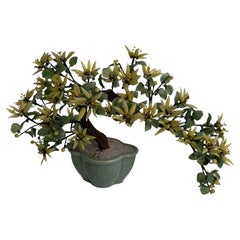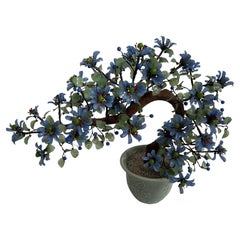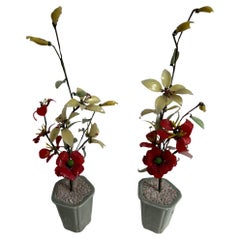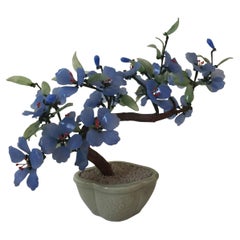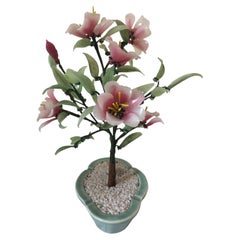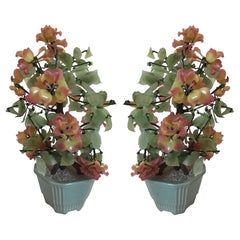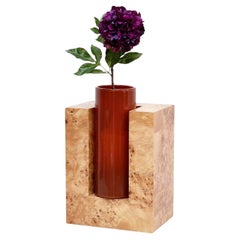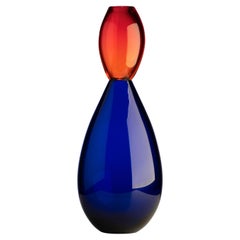Luxurydesignstore Planters, Cachepots and Jardinières
to
7
7
7
7
7
7
7
5
2
7
7
7
Height
to
Width
to
7
7
7
Big Yellow Bonsai, Glass and Ceramic
Located in Ciudad Autónoma Buenos Aires, C
We have specialized in the sale of Art Deco and Art Nouveau and Vintage styles since 1982. If you have any questions we are at your disposal.
Pushing the button that reads 'View All ...
Category
Vintage 1980s Japanese Mid-Century Modern Planters, Cachepots and Jardin...
Materials
Ceramic, Art Glass
Big Bonsai, Glass and Ceramic
Located in Ciudad Autónoma Buenos Aires, C
We have specialized in the sale of Art Deco and Art Nouveau and Vintage styles since 1982. If you have any questions we are at your disposal.
Pushing the button that reads 'View All From Seller'. And you can see more objects to the style for sale.
Why are there so many antiques in Argentina?
In the 1880 – 1940 there was a grate wave of immigration encouraged by the periods of war that were taking place.
1st World War took place between 1914 and 1918
2nd World War took place between 1939 and 1945
The immigrants options were New York or Buenos Aires. Tickets were cheap and in Buenos Aires they were welcomed with open arms, as it was a country where everything was still to be done.
Argentina was the country of new opportunities, labour was needed and religious freedom was assured, in many cases the of the family travel first until they were settled and then the rest of the family members join them.
In the immigrant museum “Ellis Island Immigrant Building” in New York you can se the promotional posters of the boats that would take them to a new life.
Between the years 1895 and 1896, Argentina had the highest DGP (gross domestic product) per capita in the world according to the Maddison Historical Statistics index, this situation arose due to the large amount of food being exported to European countries, which were at war.
The Argentinean ships left the port of Buenos Aires with food, but they returned with furniture, clothes and construction elements, (it´s common to see this the old buildings of the historic neighbourhood of San Telmo, the beams with the inscription “Made in England)”, as well as many markets that were built in Buenos Aires, such us the San Telmo Market, whose structure was brought by ship and afterwards assembled in 900 Defensa Street.
With the great influence of European immigrants living in the country, the children of the upper classes travelled to study in France, resulting in the inauguration of “La Maison Argentinienne”, on 27th of June 1928, in the international city of Paris, which hosted many Argentinians that were studying in Frace.
It´s the fourth house to be built after France, Canada and Belgium, being the first Spanish-speaking one. Still in place today (17 Bd Jourdan, 75014, Paris, France). Many of the children of these wealthy families who attended international art exhibitions, museums and art courses abroad, took a keen interest in the European style. This is why Buenos Aires was at the time referred as “The Paris of South America”.
Between the years 1890 and 1920 more than a hundred Palaces were built on Alvear Avenue the most exclusive avenue in Buenos Aires. Today some of these palaces have been transformed into museums, hotels and embassies.
In the year 1936, the Kavanagh building was inaugurated, it was the tallest reinforced concrete building in South America.
During 1994 the American Society of Civil Engineers distinguished it as an “international engineering milestone”, and it´s now considered a World Heritage of Modern Architecture.
At the time was common to hire foreign architects such as Le Corbusier, who visited Buenos Aires/Argentina in 1929 and in 1948 he drew up the blueprints for a house built in La Plata City (which was declared a World Heritage Site).
In 1947, the Hungarian architect Marcelo Breuer designed “Parador Ariston” in the seaside city of Mar del Plata. After an Argentinean student at Harvard University convinced him to come to Argentina. He worked on an urban development project in the Casa Amarilla, area of La Boca.
The Ukrainian architect, Vladimiro Acosta, arrives in Argentina in 1928 and worked as an architect until que moved to Brazil.
Antonio Bonet, a Spanish architect who worked with Le Corbusier in Paris, arrives in Argentina in 1937, where he carried out several architectural works and in 1938 designs the well-known BFK chair.
Andres Kálnay, of Hungarian origin, made around 120 architectural masterpieces, among which the former Munich brewery stands out, he even made the furniture’s design.
The German architect, Walter Gropius, director of the Bauhaus, lived in Argentina, where he wrote articles for “Sur” magazine and founded in Buenos Aires, an architectural firm with Franz Möller, who was also an architect, where he built two houses.
At the same time several famous designers decided to immigrate to Argentina, among them we can find the well-known French designer, Jean-Michel Frank, who arrived in the country in 1940 and also worked for the Rockefeller family.
Special pieces were made, which were sold exclusively in the country, such as the well-known German company “WMF”, who sold their products by catalogue, which were chosen by the ladies of High Society in the list of wedding gifts, as well as the pieces designed by Christofle.
The Swiss sculptor Alberto Giacometti, made special pieces for Argentinean mansions.
In 1904 the first Jansen branch outside Paris was established in Buenos Aires, as the Argentinean clientele demanded a large amount of furniture, from the end of the 19th Century to the mid-20th Century.
In 1970, the brand Rigolleau Argentina made pieces authorised by Lalique.
The brands Maple and Thompson also set up shop in the country.
The French plastic artist, Marcel Duchamp moved to Argentina in 1918-1919.
Glass signed Gallé, Charder, Leverre, Schneider, Muller and other French firms. They were bought in flower shops and were given to ladies with beautiful floral arrangements.
Some furniture manufacturers travelled to international fairs and bough the patterns to produce the furniture in Argentina, such as the furniture firm Englander and Bonta, who bought the patterns ins Italy.
It is worth mentioning that in Argentina we have the largest Community of Italians outside...
Category
Vintage 1980s Japanese Mid-Century Modern Planters, Cachepots and Jardin...
Materials
Art Glass, Ceramic
Pair of Bonsai, Glass and Ceramic, 1980
Located in Ciudad Autónoma Buenos Aires, C
We have specialized in the sale of Art Deco and Art Nouveau and Vintage styles since 1982. If you have any questions we are at your disposal.
Pushing the button that reads 'View All ...
Category
Vintage 1980s Japanese Mid-Century Modern Planters, Cachepots and Jardin...
Materials
Ceramic, Art Glass
Bonsai Blue 1980, Glass and Ceramic
Located in Ciudad Autónoma Buenos Aires, C
We have specialized in the sale of Art Deco and Art Nouveau and Vintage styles since 1982. If you have any questions we are at your disposal.
Pushing the button that reads 'View All From Seller'. And you can see more objects to the style for sale.
Why are there so many antiques in Argentina?
In the 1880 – 1940 there was a grate wave of immigration encouraged by the periods of war that were taking place.
1st World War took place between 1914 and 1918
2nd World War took place between 1939 and 1945
The immigrants options were New York or Buenos Aires. Tickets were cheap and in Buenos Aires they were welcomed with open arms, as it was a country where everything was still to be done.
Argentina was the country of new opportunities, labour was needed and religious freedom was assured, in many cases the of the family travel first until they were settled and then the rest of the family members join them.
In the immigrant museum “Ellis Island Immigrant Building” in New York you can se the promotional posters of the boats that would take them to a new life.
Between the years 1895 and 1896, Argentina had the highest DGP (gross domestic product) per capita in the world according to the Maddison Historical Statistics index, this situation arose due to the large amount of food being exported to European countries, which were at war.
The Argentinean ships left the port of Buenos Aires with food, but they returned with furniture, clothes and construction elements, (it´s common to see this the old buildings of the historic neighbourhood of San Telmo, the beams with the inscription “Made in England)”, as well as many markets that were built in Buenos Aires, such us the San Telmo Market, whose structure was brought by ship and afterwards assembled in 900 Defensa Street.
With the great influence of European immigrants living in the country, the children of the upper classes travelled to study in France, resulting in the inauguration of “La Maison Argentinienne”, on 27th of June 1928, in the international city of Paris, which hosted many Argentinians that were studying in Frace.
It´s the fourth house to be built after France, Canada and Belgium, being the first Spanish-speaking one. Still in place today (17 Bd Jourdan, 75014, Paris, France). Many of the children of these wealthy families who attended international art exhibitions, museums and art courses abroad, took a keen interest in the European style. This is why Buenos Aires was at the time referred as “The Paris of South America”.
Between the years 1890 and 1920 more than a hundred Palaces were built on Alvear Avenue the most exclusive avenue in Buenos Aires. Today some of these palaces have been transformed into museums, hotels and embassies.
In the year 1936, the Kavanagh building was inaugurated, it was the tallest reinforced concrete building in South America.
During 1994 the American Society of Civil Engineers distinguished it as an “international engineering milestone”, and it´s now considered a World Heritage of Modern Architecture.
At the time was common to hire foreign architects such as Le Corbusier, who visited Buenos Aires/Argentina in 1929 and in 1948 he drew up the blueprints for a house built in La Plata City (which was declared a World Heritage Site).
In 1947, the Hungarian architect Marcelo Breuer designed “Parador Ariston” in the seaside city of Mar del Plata. After an Argentinean student at Harvard University convinced him to come to Argentina. He worked on an urban development project in the Casa Amarilla, area of La Boca.
The Ukrainian architect, Vladimiro Acosta, arrives in Argentina in 1928 and worked as an architect until que moved to Brazil.
Antonio Bonet, a Spanish architect who worked with Le Corbusier in Paris, arrives in Argentina in 1937, where he carried out several architectural works and in 1938 designs the well-known BFK chair.
Andres Kálnay, of Hungarian origin, made around 120 architectural masterpieces, among which the former Munich brewery stands out, he even made the furniture’s design.
The German architect, Walter Gropius, director of the Bauhaus, lived in Argentina, where he wrote articles for “Sur” magazine and founded in Buenos Aires, an architectural firm with Franz Möller, who was also an architect, where he built two houses.
At the same time several famous designers decided to immigrate to Argentina, among them we can find the well-known French designer, Jean-Michel Frank, who arrived in the country in 1940 and also worked for the Rockefeller family.
Special pieces were made, which were sold exclusively in the country, such as the well-known German company “WMF”, who sold their products by catalogue, which were chosen by the ladies of High Society in the list of wedding gifts, as well as the pieces designed by Christofle.
The Swiss sculptor Alberto Giacometti, made special pieces for Argentinean mansions.
In 1904 the first Jansen branch outside Paris was established in Buenos Aires, as the Argentinean clientele demanded a large amount of furniture, from the end of the 19th Century to the mid-20th Century.
In 1970, the brand Rigolleau Argentina made pieces authorised by Lalique.
The brands Maple and Thompson also set up shop in the country.
The French plastic artist, Marcel Duchamp moved to Argentina in 1918-1919.
Glass signed Gallé, Charder, Leverre, Schneider, Muller and other French firms. They were bought in flower shops and were given to ladies with beautiful floral arrangements.
Some furniture manufacturers travelled to international fairs and bough the patterns to produce the furniture in Argentina, such as the furniture firm Englander and Bonta, who bought the patterns ins Italy.
It is worth mentioning that in Argentina we have the largest Community of Italians outside...
Category
Vintage 1980s Japanese Mid-Century Modern Planters, Cachepots and Jardin...
Materials
Art Glass, Ceramic
Bonsai Pink 1980, Glass and Wood
Located in Ciudad Autónoma Buenos Aires, C
We have specialized in the sale of Art Deco and Art Nouveau and Vintage styles since 1982. If you have any questions we are at your disposal.
Pushing the button that reads 'View All ...
Category
Vintage 1980s Japanese Mid-Century Modern Planters, Cachepots and Jardin...
Materials
Art Glass, Wood
Pair of Bonsai 1980, Glass and Ceramic
Located in Ciudad Autónoma Buenos Aires, C
We have specialized in the sale of Art Deco and Art Nouveau and Vintage styles since 1982. If you have any questions we are at your disposal.
Pushing the button that reads 'View All ...
Category
Vintage 1980s Japanese Mid-Century Modern Planters, Cachepots and Jardin...
Materials
Art Glass, Ceramic
Bonsai 1980, Glass and Wood
Located in Ciudad Autónoma Buenos Aires, C
We have specialized in the sale of Art Deco and Art Nouveau and Vintage styles since 1982. If you have any questions we are at your disposal.
Pushing the button that reads 'View All ...
Category
Vintage 1980s Japanese Mid-Century Modern Planters, Cachepots and Jardin...
Materials
Wood, Art Glass
Related Items
Ettore Sottsass Y Limited Edition Vase in Wood and Murano Glass for Flowers
By Ettore Sottsass, Design Gallery Milano
Located in Barcelona, Barcelona
Y vase made for the collection of twenty-seven woods for Chinese artificial flowers vase by Ettore Sottsass,
Edited by Design Gallery Milano, 1995.
Limited edition of 12 numbered pi...
Category
1990s European Modern Vases
Materials
Glass, Wood
$7,293 Sale Price
35% Off
H 19.3 in W 12.6 in D 9.06 in
21st Century Karim Rashid King Vase Murano Glass Oriental Red and Ocean Blue
By Purho Murano, Karim Rashid
Located in Brembate di Sopra (BG), IT
21st century Karim Rashid king vase Murano glass various colors.
King designed by Karim Rashid is a curvaceous vase that combine regality with visual wit. Proposed in combination wi...
Category
21st Century and Contemporary Italian Modern Vases
Materials
Murano Glass
$1,540 / item
H 15.75 in Dm 3.15 in
Pair of Ceramic Vases Sculptures One of a Kind Signed by French Ceramist Dalo
By Dalo
Located in Paris, FR
A set of two "Idoles", decorative vases in clay with stylized faces, handmade by French ceramicists Dalo
Earthenware with shiny blue and green enamel
One of a kind, creation 2022 s...
Category
21st Century and Contemporary Figurative Sculptures
Materials
Ceramic
$2,189 Sale Price / set
20% Off
H 7.49 in Dm 5.12 in
Sand Big Sphere Vase Bubl by 101 Copenhagen
Located in Geneve, CH
Sand big sphere vase Bubl by 101 Copenhagen.
Designed by Kristian Sofus Hansen & Tommy Hyldahl.
Dimensions: L 31,5 / W 14 / H 45 cm.
Materials: Ceramic
The Sphere collection celebrates unique silhouettes and textures that makes an impact with the decorative charm of sculptural art. Elegantly sculpted, each vase is finished in intricate ornate detailing. Inspired by ancient Chinese vases...
Category
2010s Danish Modern Vases
Materials
Ceramic
Mario Badioli after Picasso Black and Orange Sommerso Murano Glass Vase, 1980s
Located in Roma, IT
Midcentury amazing black and orange sommerso Murano glass vase. Mario Badioli probably designed this fantastic piece in the style of Picasso in Italy dur...
Category
Mid-20th Century Italian Mid-Century Modern Vases
Materials
Glass, Art Glass, Murano Glass
$1,534
H 13 in W 9.45 in D 3.94 in
Anna Torfs Valenta Glass Bowl in Water Blue
Located in Los Angeles, CA
Anna Torfs large valenta glass bowl in water blue with sanded finish. Available in other colors.
Category
2010s Czech Vases
Materials
Glass
Ceramic Stylised Bird Vase by Dominique Pouchain 'circa 1980s'
By Dominique Pouchain
Located in London, GB
French glazed ceramic stylised bird vase by Dominique Pouchain (circa 1980s). Quirky and original, these ceramic birds are by the son of Jacques Pouchain, well-known French ceramicis...
Category
Vintage 1980s French Animal Sculptures
Materials
Ceramic
$715 Sale Price
30% Off
H 5.71 in W 6.11 in D 5.12 in
Contemporary Crystal Blue Design Italian Art Glass Vase Baloton Murano Glass Jar
By Murano 5
Located in Murano, Venezia
Handmade blue Murano glass vase with internal bubble decorations and lateral crystal.
This fantastic Art Deco style artwork will add an extra touch of class to your environment.
Va...
Category
21st Century and Contemporary Italian Art Deco Jars
Materials
Gold Leaf
$1,098 / item
H 14.18 in Dm 8.67 in
Ettore Sottsass Y Limited Edition Vase in Wood and Murano Glass for Flowers
By Design Gallery Milano, Ettore Sottsass
Located in Barcelona, Barcelona
Y Vase made for the collection of Twenty-seven Woods for Chinese Artificial flowers vase by Ettore Sottsass,
Edited by Design Gallery Milano, 1995.
Limited edition of 12 numbered p...
Category
1990s European Modern Vases
Materials
Glass, Wood
$7,346 Sale Price
35% Off
H 19.3 in W 12.6 in D 9.06 in
Anna Torfs Large Double Bubble Solo Glass Sculpture in Powder Pink
Located in Los Angeles, CA
Anna Torfs large double bubble solo glass sculpture in powder with sanded finish. Available in other colors. Shipping from Europe not included.
Category
2010s Czech Vases
Materials
Glass
Group of 1960's Square Studio Ceramic Vases in Ocher and Earth Tones
By Mobach
Located in London, GB
Set of eight Mid-Century Modern square studio pottery vases glazed in ocher and natural earth tones hand formed and in various heights by Mobach's Dutch ceramist made in the 1960's. ...
Category
Vintage 1960s Dutch Mid-Century Modern Vases
Materials
Ceramic
$1,158 / set
H 8.67 in W 14.18 in D 7.09 in
Anna Torfs Small Double Bubble Solo Clear Glass Sculpture in Powder Pink
Located in Los Angeles, CA
Anna Torfs small double bubble solo clear glass sculpture or vase in powder pink with sanded finish.
Available in different colors. Shipping fro...
Category
2010s Czech Vases
Materials
Glass
$2,250 / item
H 4.5 in Dm 7 in
